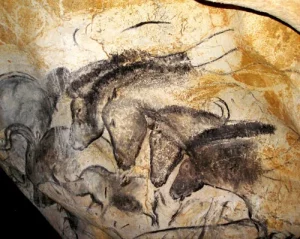grotte chauvet-pont d’Arc
The Chauvet Cave was discovered in the Ardèche valley in southern France in December 1994 by three cave explorers, after removing the rumble of stones that blocked a passage. The cave is extensive, about 400 meters long, with vast chambers. The floor of the cave is littered with archaeological and paleontological remains, including the skulls and bones of cave bears, which hibernated there, along with the skulls of an ibex and two wolves. The cave bears also left innumerable scratches on the walls and footprints on the ground. The two major parts of the cave were used in different ways by artists. In the first part, a majority of images are red, with few black or engraved ones. In the second part, the animals are mostly black, with far fewer engravings and red figures. Obvious concentrations of images occur in certain places. The most spectacular images are the Horse Panel and the Panel of Lions and Rhinoceroses. A limitless palette, the first use of the stump technique, the use of overhangs, hollows, niches and alcoves in the rock to give relief and the mastery of perspective: the quality of the artists’ techniques in the Chauvet cave – the most accomplished known to date for the Upper Palaeolithic period.
The Chauvet Cave a vast array, more than 1000, and unique collection of cave paintings dated between 32,000 – 36,000 years old which makes them some of the oldest cave paintings in the world
Grotte Chauvet-Pont d’Arc, Ardèche – whc.unesco.org
The Chauvet Cave, France – 1994
